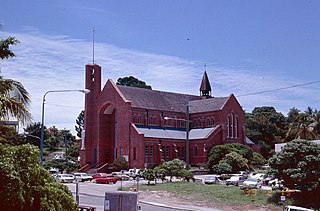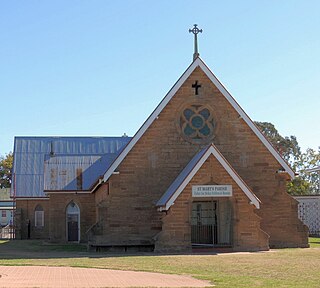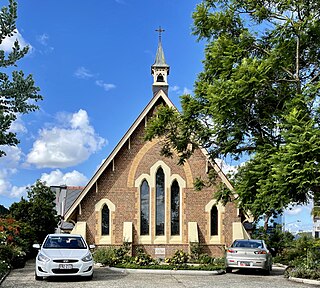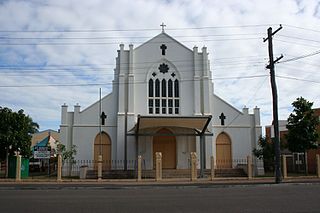
The Roman Catholic Diocese of Bathurst (Australia) is a Latin Church suffragan diocese of the Metropolitan Archdiocese of Sydney, established in 1865, covering the Central West and Orana regions of New South Wales, Australia.

St James' Cathedral is a heritage-listed cathedral of the Anglican Diocese of North Queensland at 36 Cleveland Terrace, Townsville, City of Townsville, Queensland, Australia. It was designed by Arthur Blacket and was built in 1887 by MacMahon & Cliffe. It was added to the Queensland Heritage Register on 21 October 1992.

The First St Mary's Roman Catholic Church is a heritage-listed sandstone Roman Catholic former church building at 163 Palmerin Street, Warwick, Southern Downs Region, Queensland, Australia. It was designed by Benjamin Joseph Backhouse and built from 1863 to 1865 by CA Doran. It is also known as St Mary of the Assumption Church and St Mary's Church. It was added to the Queensland Heritage Register on 21 October 1992.

St Paul's Anglican Cathedral is an Australian heritage-listed cathedral at 89 William Street, Rockhampton, Rockhampton Region, Queensland. It was designed principally by Annersley Voysey and built from 1883 to 1953. It is also known as St Paul's Church of England and St Paul's Church of England Cathedral. It was added to the Queensland Heritage Register on 21 October 1992. The associated hall and offices were listed on the Queensland Heritage Register on 23 June 2000.

The second St Mary's Roman Catholic Church is a heritage-listed sandstone Catholic church at 163 Palmerin Street in Warwick in the Southern Downs Region, Queensland, Australia. It was designed by Dornbusch & Connolly and built from 1920 to 1926. It is also known as St Mary of the Assumption Church. It was added to the Queensland Heritage Register on 21 October 1992.

St Mary's Church is a heritage-listed Roman Catholic church at 271–275 Adelaide Street, Maryborough, Fraser Coast Region, Queensland, Australia, on land donated to the Church by Maryborough pioneer James Cleary. It was initially designed by Charles Tiffin with later additions and alterations by Francis Drummond Greville Stanley and POE Hawkes. The initial construction was from 1869 to 1872 by G Smith and J Thomas. It was added to the Queensland Heritage Register on 21 October 1992.

John Cani, also known as Giovanni Cani was a Roman Catholic Bishop of Rockhampton.

St Thomas' Anglican Church is a heritage-listed church at 69 High Street, Toowong, City of Brisbane, Queensland, Australia. It was designed by Francis Drummond Greville Stanley and built in 1877 by Henry Pears. It was also known as St Thomas' Church of England. It was added to the Queensland Heritage Register on 21 October 1992.

St Patrick's Church is a heritage-listed Roman Catholic church at 58 Morgan Street, Fortitude Valley, City of Brisbane, Queensland, Australia. It was designed by Andrea Giovanni Stombuco and built from 1880 to 1882 by John Arthur Manis O'Keefe. It was added to the Queensland Heritage Register on 21 October 1992.

Sacred Heart Cathedral is a heritage-listed Roman Catholic cathedral at 266 Stanley Street, Townsville CBD, City of Townsville, Queensland, Australia. It was built from 1896 to 1902 by Dennis Kelleher. It is also known as Church of the Sacred Heart. It was added to the Queensland Heritage Register on 21 October 1992.

St Mary's Church is a heritage-listed Roman Catholic church precinct at Mary Street, Woodend, Ipswich, City of Ipswich, Queensland, Australia. It was built from 1874 to 1970s. It is also known as the former St Brigids Convent. It was added to the Queensland Heritage Register on 21 October 1992.

St Patrick's Church is a heritage-listed Roman Catholic church at Church Street, Gympie, Gympie Region, Queensland, Australia. It was designed by Francis Drummond Greville Stanley and built from 1883 to 1935. It was added to the Queensland Heritage Register on 20 February 1995.

St Paul's Anglican Church is a heritage-listed church at 178-202 Adelaide Street, Maryborough, Fraser Coast Region, Queensland, Australia. It was designed by Francis Drummond Greville Stanley and built from 1878 to 1921. It was added to the Queensland Heritage Register on 21 October 1992.

Our Lady Star of the Sea Church & School is a heritage-listed Roman Catholic church and school at Goondoon Street, Gladstone, Gladstone Region, Queensland, Australia. It was built from 1924 to 1950. It was added to the Queensland Heritage Register on 21 October 1992.

St Paul's Anglican Cathedral Hall is a heritage-listed church hall at 89 William Street, Rockhampton, Rockhampton Region, Queensland, Australia. It is adjacent to St Paul's Anglican Cathedral. It was designed by Louis Spier Robertson and built c. 1900. It is also known as St Paul's Anglican Cathedral Offices, St Paul's Anglican Cathedral Parish Hall, and St Paul's Day School (1902–1912). It was added to the Queensland Heritage Register on 23 June 2000.

St Mark's Anglican Church is a heritage-listed former church at 36 Larnach Street, Allenstown, Rockhampton, Rockhampton Region, Queensland, Australia. It was designed by architect Louis Spier Robertson and was built in 1900. It was added to the Queensland Heritage Register on 28 July 2000.

St Joseph's Church is a heritage-listed Roman Catholic church at Fryer Street, North Ward, City of Townsville, Queensland, Australia. It was designed by Charles Dalton Lynch and Walter Hunt and built from 1920 to 1921 by Joseph Rooney. It is also known as St Joseph on The Strand. It was added to the Queensland Heritage Register on 26 November 1999.

St Patrick's Convent is a heritage-listed Roman Catholic convent at 45 The Strand, North Ward, City of Townsville, Queensland, Australia. It was built in c. 1883. It was added to the Queensland Heritage Register on 3 February 2012.

St Monica's Cathedral is the cathedral of the Catholic Church in the Diocese of Cairns. It is located at 183 Abbott Street, Cairns City, Cairns, Queensland, Australia. The cathedral was designed by Ian Ferrier and built from 1967 to 1968. It was added to the Queensland Heritage Register on 31 August 1998.

Saints Mary and Joseph Catholic Cathedral is a heritage-listed cathedral at 132 Dangar Street, Armidale, Armidale Regional Council, New South Wales, Australia. It is the diocesan cathedral of the Roman Catholic Diocese of Armidale and the seat of the Catholic Bishop of Armidale. The cathedral was designed by John Hennessy of Sheerin and Hennessy, and built from 1911 to 1912 by George Frederick Nott. It is also known as the St Mary & St Joseph Catholic Cathedral and the Cathedral of Saint Mary and Saint Joseph. It was added to the New South Wales State Heritage Register on 13 February 2015.

























